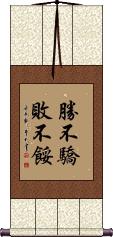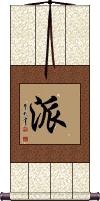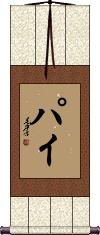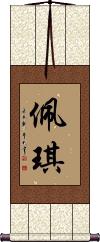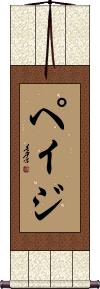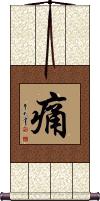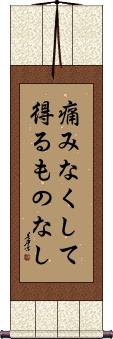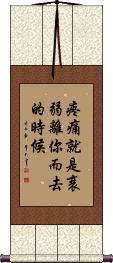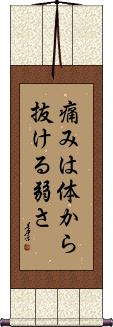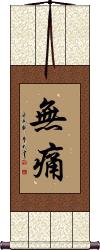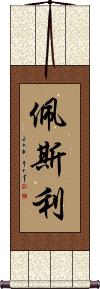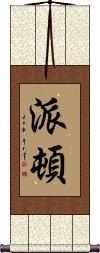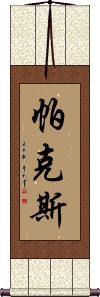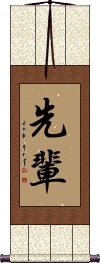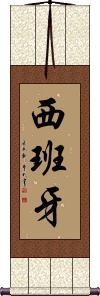The Name Pai in Japanese/Chinese on a Custom-Made Wall Scroll.
Click the "Customize" button next to your name below to start your personalized pai calligraphy artwork...
Switched to secondary search mode due to lack of results using primary.
These secondary results may not be very accurate. Try a different but similar meaning word or phrase for better results. Or...
Look up Pai in my Japanese Kanji & Chinese Character Dictionary(My dictionary is a different system then the calligraphy search you just tried)
If you want a special phrase, word, title, name, or proverb, feel free to contact me, and I will translate your custom calligraphy idea for you.
1. No arrogance in victory, No despair in defeat
2. Pai
3. Paic
4. Paige
5. Pain
7. The Pain of Love / Love Troubles
8. The Pain of Separation from Your Loves
9. Pain is Weakness Leaving the Body
10. Paine
11. Painless
12. Paisley
13. Paiton
14. Paiva
15. Paix
16. Paix de l'esprit
17. Paiz
18. There is no pleasure without pain
19. Senpai / The Elder or Master
20. Spain
No arrogance in victory, No despair in defeat
Paic
Paic
Paige
Paige
Pain
ache / sorrow
痛 means pain in Chinese and old Korean Hanja. It also means pain/hurt/bruise in Japanese but is seldom seen as a single Kanji (usually, at least a Hiragana is added to make the word “itai” which is what a Japanese person will scream when they are in pain).
Depending on the context, this word can mean hurt, ache, sorrow, or refer to damage to a human body. As a single character, the possible meanings are very open - so you can decide what it means to you, as long as the general meaning is still “painful.”
See Also: Hurt
No Pain No Gain
Literally: No Pain, No Strength
No Pain No Gain
痛みなくして得るものなし is a Japanese phrase that means “no pain, no gain.”
This suggests that with pain, a gain must follow.
The pain Kanji here can also be translated as sorrow or suffering. The gain can also mean profit, advantage, or benefit. In the Japanese Buddhist context, that gain Kanji can mean rebirth in paradise, entering nirvana.
The character breakdown:
痛みなく (itami naku) pain; ache; sore; grief; distress. The naku part adds the meaning of “a lot of” or “extended”
して (shite) and then. (indicates a causative expression; acts as a connective particle)
得る (eru) to get; to acquire; to obtain; to procure; to earn; to win; to gain; to secure; to attain.
もの (mono) conjunctive particle indicating a cause or reason.
なし (nashi) none of; -less; without; no.
Note: Because this selection contains some special Japanese Hiragana characters, it should be written by a Japanese calligrapher.
The Pain of Love / Love Troubles
The Pain of Separation from Your Loves
愛別離苦 is a Buddhist term that refers to “the pain of separation from loved ones,” or “the suffering of being separated from those whom one loves.”
If you translate each character separately, you get, “love(s) separated [and] departed [yields] pain.”
The pain character can also be defined as anguish; suffering; distress; anxiety; worry; trouble; difficulty; hardship; bitterness; to suffer; anguish; distress; anxiety; worry; trouble; difficulty; bitterness; unhappiness; or misery.
Pain is Weakness Leaving the Body
I remember this being shouted a lot during U.S. Marine Corps boot camp. 疼痛就是衰弱離你而去的時候 is how to write that phrase in Chinese. At least, this is as close as we could compose/translate it, and hold the full original meaning and connotations.
The version shown here is really, “Pain is weakness leaving your body.” Although it's said in English both ways (the or your), it works better in Chinese with “your.”
Pain is Weakness Leaving the Body
痛みは体から抜ける弱さ is how to write “pain is weakness leaving the body” in Japanese.
I remember this being shouted a lot during U.S. Marine Corps boot camp.
Note: Because this selection contains some special Japanese Hiragana characters, it should be written by a Japanese calligrapher.
Paine
Paine
Painless
無痛 is the Chinese, Japanese Kanji, and old Korean Hanja for painless or without pain.
無痛 is not a common title for a wall scroll, so select this only if it has a deep personal meaning to you.
Paisley
Paisley
Paiton
Paiton
Paiva
Paix
Paix
Paix de l'esprit
Paiz
Paiz
There is no pleasure without pain
No pain, no gain
Senpai / The Elder or Master
先輩 is a Chinese, Japanese, and old Korean word or title that means elders, senior (at work or school), superior, older graduate, progenitor, or old-timer.
In American dojos, this is sometimes romanized as Sempai.
Spain
西班牙 is the Chinese name for the country of Spain.
This is sometimes used in Japanese too, though in modern times, Japanese tend to use a Katakana version of Spain.
See Also: Europe
Spain
This is the Japanese Katakana name for the country of Spain.
Note: Because this title is entirely Japanese Katakana, it should be written by a Japanese calligrapher.
See Also: Europe
The following table may be helpful for those studying Chinese or Japanese...
| Title | Characters | Romaji (Romanized Japanese) | Various forms of Romanized Chinese | |
| No arrogance in victory, No despair in defeat | 勝不驕敗不餒 胜不骄败不馁 | shèng bù jiāo bài bù něi sheng4 bu4 jiao1 bai4 bu4 nei3 sheng bu jiao bai bu nei shengbujiaobaibunei | sheng pu chiao pai pu nei shengpuchiaopaipunei |
|
| Pai | 派 | pài / pai4 / pai | p`ai / pai | |
| Pai | パイ | pai | ||
| Paic | 派克 | pài kè / pai4 ke4 / pai ke / paike | p`ai k`o / paiko / pai ko | |
| Paic | ペイク | peiku | ||
| Paige | 佩琪 | pèi qí / pei4 qi2 / pei qi / peiqi | p`ei ch`i / peichi / pei chi | |
| Paige | ペイジ | peiji | ||
| Pain | 痛 | tsuu / ita / tsu / ita | tòng / tong4 / tong | t`ung / tung |
| No Pain No Gain | 不痛不強 不痛不强 | bú tòng bù qiáng bu2 tong4 bu4 qiang2 bu tong bu qiang butongbuqiang | pu t`ung pu ch`iang putungpuchiang pu tung pu chiang |
|
| No Pain No Gain | 痛みなくして得るものなし | itami naku shite erumono wa nashi | ||
| The Pain of Love Love Troubles | 戀の悩み 恋の悩み | koinonayami | ||
| The Pain of Separation from Your Loves | 愛別離苦 爱别离苦 | ai betsu ri ku aibetsuriku | ài bié lí kǔ ai4 bie2 li2 ku3 ai bie li ku aibieliku | ai pieh li k`u aipiehliku ai pieh li ku |
| Pain is Weakness Leaving the Body | 疼痛就是衰弱離你而去的時候 疼痛就是衰弱离你而去的时候 | téng tòng jiù shì shuāi ruò lí nǐ ér qù de shí hòu teng2 tong4 jiu4 shi4 shuai1 ruo4 li2 ni3 er2 qu4 de shi2 hou4 teng tong jiu shi shuai ruo li ni er qu de shi hou | t`eng t`ung chiu shih shuai jo li ni erh ch`ü te shih hou teng tung chiu shih shuai jo li ni erh chü te shih hou |
|
| Pain is Weakness Leaving the Body | 痛みは體から抜ける弱さ 痛みは体から抜ける弱さ | itami wa karada kara nukeru yowasa | ||
| Paine | 潘恩 | pān ēn / pan1 en1 / pan en / panen | p`an en / panen / pan en | |
| Paine | ペイン | pein | ||
| Painless | 無痛 | mutsuu / mutsu | wú tòng / wu2 tong4 / wu tong / wutong | wu t`ung / wutung / wu tung |
| Paisley | 佩斯利 | pèi sī lì pei4 si1 li4 pei si li peisili | p`ei ssu li peissuli pei ssu li |
|
| Paisley | ペイズリー | peizurii / peizuri | ||
| Paiton | 派頓 派顿 | pài dùn / pai4 dun4 / pai dun / paidun | p`ai tun / paitun / pai tun | |
| Paiton | パイトン | paiton | ||
| Paiva | 帕伊瓦 | pà yī wǎ pa4 yi1 wa3 pa yi wa payiwa | p`a i wa paiwa pa i wa |
|
| Paix | 帕克斯 | pà kè sī pa4 ke4 si1 pa ke si pakesi | p`a k`o ssu pakossu pa ko ssu |
|
| Paix | ペーックス | peekkusu / pekusu | ||
| Paix de l'esprit | 內心的平靜 内心的平静 | nèi xīn de píng jìng nei4 xin1 de ping2 jing4 nei xin de ping jing neixindepingjing | nei hsin te p`ing ching neihsintepingching nei hsin te ping ching |
|
| Paiz | 帕伊斯 | pà yī sī pa4 yi1 si1 pa yi si payisi | p`a i ssu paissu pa i ssu |
|
| Paiz | ペイズ | peizu | ||
| There is no pleasure without pain | 苦は楽の種 | ku wa raku no tane kuwarakunotane | ||
| Senpai The Elder or Master | 先輩 先辈 | sen pai / senpai | xiān bèi / xian1 bei4 / xian bei / xianbei | hsien pei / hsienpei |
| Spain | 西班牙 | supein | xī bān yá xi1 ban1 ya2 xi ban ya xibanya | hsi pan ya hsipanya |
| Spain | スペイン | supein | ||
| In some entries above you will see that characters have different versions above and below a line. In these cases, the characters above the line are Traditional Chinese, while the ones below are Simplified Chinese. | ||||
